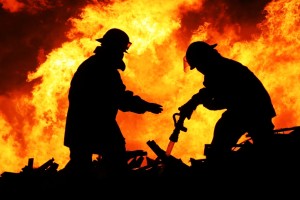Choosing the best residential roof means considering the roof fire rating. In addition to cost, eco-friendliness, weight and upkeep, how a roof would fare in a fire should be a top priority for

The American Society for Testing and Materials (ASTM) tests and defines the fire ratings of roofing materials. When a material is non-combustible, such as steel or concrete, flames can only spread on the top part of the surface. The best rating is Class A (six-foot spread), followed by Class B (eight foot) and Class C (13 feet). Overall, the steeper a roof slope is, the higher the danger posed by fire, due to a snowball effect produced by melting materials that can feed a fire.
The Roof Is on Fire!
Obviously, a non-combustible roofing material like aluminum is the most fire-resistant. However, combustible roofs like wood are also popular and have their own advantages not related to fire security. Wood demands two tests — one for the top surface and one from underneath (to test the resistance of a fire that originates from inside the home). These tests include “the burning brand” and “the intermittent flame test.” The burning brand is administered by putting a lit wood lattice over the test piece to see how fast it catches fire. The intermittent flame test requires a gas flame to be turned off and on under the wood. To achieve a Class A rating, the test piece must last at least 15 trials before catching fire.
The Whole, Flaming Enchilada
When gauging the complete fire resistance of a home, bear in mind that the roof is only the cherry on top. Total structural elements should also be considered, including the entirety of the roof from the membrane to the surface. Testing includes a 25-foot chamber (Steiner Tunnel) to see how a flame travels along the underside of a roof. In order to achieve a Class A rating, flames cannot go farther than 10 feet in 10 minutes or 14 feet in the total 30-minute test.
A Class A rating is ideal, but it does not mean a roof is fireproof. There are other considerations, such as the thickness of the roof. Thinner roofs are better fire fighters, since they provide less fuel. However, thicker roofs furnish more durability against flames. Fire resistance does not have to be the only focus when choosing a roof, but it should make the Top 5 cut.
To protect your home from fire damage, trust the knowledgeable professionals at The Roof Doctor to help you choose the right roofing supplies.

